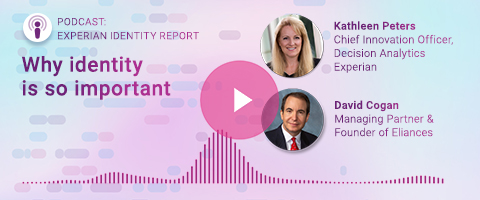Latest Posts

Financial institutions have gone through a whirlwind in the last few years, with the pandemic forcing many to undergo digital transformations. More recently, rising interest rates and economic uncertainty are leading to a pullback, highlighting the need for lenders to level up their marketing strategies to win new customers. To get started, here are a few key trends to look out for in the new year and fresh marketing ideas for lenders. Challenges and consumers expectations in 2023 It might be cliche to mention the impact that the pandemic had on digital transformations — but that doesn't make it any less true. Consumers now expect a straightforward online experience. And while they may be willing to endure a slightly more manual process for certain purchases in their life, that's not always necessary. Lenders are investing in front-end platforms and behind-the-scenes technology to offer borrowers faster and more intuitive services. For example, A McKinsey report from December 2021 highlighted the growth in nonbank mortgage lenders. It suggested nonbank lenders could hold onto and may continue taking market share as these tech-focused lenders create convenient, fast and transparent processes for borrowers.2 Marketers can take these new expectations to heart when discussing their products and services. To the extent you have one in place, highlight the digital experience that you can offer borrowers throughout the application, verifications, closing and loan servicing. You can also try to show rather than tell with interactive online content and videos. Build a data-driven mortgage lending marketing strategy The McKinsey report also highlighted a trend in major bank and nonbank lenders investing in proprietary and third-party technology and data to improve the customer experience.2 Marketers can similarly turn to a data-driven credit marketing strategy to help navigate shifting lending environments. Segment prospects with multidimensional data Successful marketers can incorporate the latest technological and multidimensional data sources to find, track and reach high-value prospects. By combining traditional credit data with marketing data and Fair Credit Report Act-compliant alternative credit data* (or expanded FCRA-regulated data), you can increase the likelihood of connecting with consumers who meet your credit criteria and will likely respond. For example, Experian's mortgage-specific In the Market Models predict a consumer's propensity to open a new mortgage within a one to four-month period based on various inputs, including trended credit data and Premier Attributes. You can use these propensity models as part of your prescreen criteria, to cross-sell current customers and to help retain customers who might be considering a new lender. But propensity models are only part of the equation, especially when you're trying to extend your marketing budget with hyper-segmented campaigns. Incorporating your internal CRM data and non-FCRA data can help you further distinguish look-alike populations and help you customize your messaging. LEARN MORE: Use this checklist to find and fix gaps in your prospecting strategy Maintain a single view of your borrowers An identity management platform can give you a single view of a consumer as they move through the customer journey. The persistent identity can also help you consistently reach consumers in a post-cookie world and contact them using their preferred channel. You can add to the persistent identity as you learn more about your prospects. However, you need to maintain data accuracy and integrity if you want to get a good ROI. Use triggers to guide your outreach You can also use data-backed credit triggers to implement your marketing plan. Experian's Prospect Triggers actively monitors a nationwide database to identify credit-active consumers who have new tradelines, inquiries or a loan nearing term. Lenders using Prospect Triggers can receive real-time or periodic updates and customize the results based on their screening strategy and criteria, such as score ranges and attributes. They can then make firm credit offers to the prospects who are most likely to respond, which can improve cross-selling opportunities along with originations. Benefit from our expertise Forward-thinking lenders should power their marketing strategies with a data-backed approach to incorporate the latest information from internal and external sources and reach the right customer at the right time and place. From list building to identity management and verification, you can turn to Experian to access the latest data and analytics tools. Learn about Experian credit prescreen and marketing solutions. Explore our credit prescreen solutions Learn about our marketing solutions 1Mortgage Bankers Association (October 2022). Mortgage Applications Decrease in Latest MBA Weekly Survey 2McKinsey & Company (2021). Five trends reshaping the US home mortgage industry

Experian’s State of the Automotive Finance Market Report: Q3 2022 found that consumers with credit scores between 300 and 660—also considered as the nonprime segments—are continuing to opt for used vehicles rather than new.

Conventional credit scoring systems are based on models developed over six decades. As consumer behavior evolves, it's important to seek newer, fresher sources of data to assess creditworthiness. Because the data used by conventional credit scoring models does not provide the full picture of a consumer's financial health, a large population segment of the United States is excluded from accessing credit.With changing times and new technology, forward-thinking financial institutions are using alternative data1 to gain a more holistic consumer view. A move toward inclusive finance, including incorporating alternative data in credit scoring models, is a crucial step towards promoting financial inclusion and helping millions of consumers achieve their financial and personal goals. More importantly, it provides the insight needed for lender confidence, which can help fuel business growth. Understanding limitations of the conventional scoring system Credit scores can be obtained from any one of the major credit bureaus based on information found in a consumer's credit report and are incorporated into a lender's credit-decisioning process. While there are various credit scoring models based on lender preference that could yield slightly different scores, all traditional scores are comprised of credit characteristics within these categories: payment history, credit mix, credit history length, amounts owed and new credit account inquires. Lenders use past credit performance to predict whether extending credit is a risk, posing a major challenge for credit invisible and thin-file consumers and leaving millions at a disadvantage. This dilemma also limits business growth for lenders. Consumers who are unable to access mainstream credit often turn to the alternative financial services (AFS) industry, a $140 billion market that continues to grow by 7-10 percent each year.2 The AFS industry offers consumers additional products, like payday loans, cash advances, short-term installment loans, and rent-to-own loans, none of which are included in a traditional credit file. With alternative credit data, lenders can obtain a more holistic view of creditworthiness and risk, helping to enhance inclusive lending by broadening their pool of potential loan candidates. Why conventional scoring models simply aren't enough Because of the criteria used to assess creditworthiness, conventional credit scoring models do not accurately capture an individual's financial behavior or health. Indeed, many people demonstrate financial responsibility in other legitimate ways that are not reported to the major credit bureaus.In contrast, non-traditional data considers a consumer's everyday financial behavior to provide a more accurate score for lenders. It can include a range of indicators, such as: Bill payments: Consistent payment history on typical household bills (which may have been paid from a debit account). Bank account data: Shows average balance and withdrawal activity and recurring payroll deposits (indicating that a consumer is employed and receives a regular income). Rental data: Indicates a consumer's long-term stability in making regular, on-time monthly rent payments. Registered licenses: Registered licenses or membership with a skilled trade or profession can indicate the likelihood to generate income. Including this type of data can benefit both lenders and applicants. According to an Experian report, by adding alternative credit data to a near-prime population, lenders could see an increase in approvals for consumers historically being left behind. When Clear Early Risk Score™ is paired with the VantageScore® credit score, approvals climb to 16 percent of the population inside the same risk criteria, representing a 60 percent lift in credit approvals for near-prime consumers.2 The pool of people from whom this type of alternative data can reliably be collected is growing, with 70 percent of consumers willing to provide additional financial information to a lender if it increases their chance for approval or improves their interest rate for a mortgage or car loan.3 Plenty of available yet untapped data exists that can add value to a consumer's profile and lead to greater inclusive lending. For example, 95 percent of Americans own a cell phone and about two-thirds of households headed by young adults are being rented. Reporting on this data could potentially "thicken" a credit file and provide deeper insight into a consumer's credit behavior.3Indeed, turning to non-traditional data can expand the credit universe and lead to more inclusive credit scoring models, especially by leveraging existing technology and financial inclusion solutions. Research shows that with Lift Premium™, virtually all of the 21 million conventionally unscorable consumers would become scoreable, and over 1 million of them would have scores in the near-prime range or better. Of these, 1.7 million would be Black American and Hispanic/Latino people.3 For lenders, these numbers reveal potential opportunities to grow their businesses. Of the 255 million adults in the U.S., 19 percent of credit eligible adults are left out of mainstream scoring systems. 28 million are considered credit invisible – meaning they have no credit history (11%). 21 million are considered unscorable – have partial credit history but not enough to generate a score using conventional models (8%). Of the remaining credit eligible adults, 57 million were considered subprime (22%). 106 million U.S. adults can't get mainstream credit rates (42%). Adopting inclusive finance lending practices is not only the right thing to do but also provides financial institutions with the chance to reach untapped markets, grow their business and promote a healthier economy. Financial inclusion is not a destination, but an ever-evolving journey. Don't miss out on this critical opportunity to join the movement. Learn more about our financial inclusion tools to help enhance your inclusive lending approach. 1"Alternative Credit Data,” refers to the use of alternative data and its appropriate use in consumer credit lending decisions, as regulated by the Fair Credit Reporting Act. Hence, the term “Expanded FCRA Data” may also apply in this instance and both can be used interchangeably.2Experian: 2020 State of Alternative Credit Data.3Oliver Wyman white paper, “Financial Inclusion and Access to Credit," January 12, 2022.

The average person spends nearly seven hours a day online[1]. Much of that time consists of sharing personal information with a variety of websites, which can sometimes lead to bad actors gaining unauthorized access to your personal information for ill-intended purposes. Theft of your personal information – and subsequently, identity fraud – can have seriously damaging consequences. According to a report from the AARP, nearly 42 million Americans fell victim to identity fraud in 2021, costing $52 billion in losses[2]. You can proactively take three easy steps to protect and keep track of your personal information online. 1. Keep your information updated. Outdated information can lead to problems for your online accounts. If an old online account that you no longer use has outdated information such as a previous home address where you no longer live, or an email address you haven’t used recently, that information can sometimes be used to access your current online accounts. If a hacker has access to those details, they could potentially use that information for criminal activity such as making unauthorized transfers from your bank account. Solution: Make sure your information – name, email address, phone number, mailing address, etc. – is up to date across any websites you use frequently. This may include online shopping, financial information, medical records, email accounts, and/or social media networks. It’s also a good idea to delete any online accounts you no longer use and/or remove any out-of-date information from those accounts. 2. Switch up your passwords. Using the same password for too long, or for multiple accounts, can make it easy for hackers to obtain your personal information. Creating a secure password that’s also easy to remember can be a challenge. Many hackers will try to guess your password based on common information that’s easy to remember, such as birthdates, anniversaries, names of family members or pets, or street addresses. Solution: Change your password at least every six months for any websites where you’ve shared your personal information, and make sure this password can’t be easily guessed. Avoid special dates, names, or street addresses. Using a password manager can help you generate stronger passwords and keep track of existing ones across multiple online accounts, while safely storing and protecting your login information in one place. 3. Add two-factor authentication when possible. Without it, hackers can more easily break into your accounts and gain access to your personal information. Two-factor authentication adds a second layer of defense against people who try to gain access to your online accounts without your permission. Without it, a hacker only needs to obtain your email address and guess your password to get into your account and steal your personal information. Solution: Enable two-factor authentication for as many of your online accounts as possible. When this feature is turned on, a temporary code will be sent to your phone or email inbox whenever you attempt to log in to your account. Since hackers will not have access to this code, they will not be able to access your account. Identity theft is a serious concern with potentially severe consequences. Avoid any unnecessary risk by: Keeping your information up to date Changing your passwords often Adding two-factor authentication when possible By taking these proactive steps, you can drastically reduce your risk of falling victim to identity theft while maintaining control of your personal information online. Learn more about our identity protection services [1] Oberlo. 2022. How Much Time Does the Average Person Spend on the Internet? [2] AARP. 2022. Identity Fraud Hit 42 Million People in 2021.

The collections landscape is changing due to shifting consumer behaviors, demands, regulations and an economy that’s in a constant state of flux. As the market evolves, the need for greater insight and analysis grows. Matthew Baltzer, Experian’s Senior Director of Product Marketing, discusses challenges facing the collections industry and how you can continue to build a profitable portfolio. For more information on enhancing your collections strategy, view our full Q&A video. Q: Which macroeconomic trends should debt collectors be the most aware of and why? A:While we are still seeing a reasonably healthy consumer, there are trends to monitor. The first would be employment, which continues to be strong. Laid-off individuals are typically able to move back into the labor force. Second, we're seeing strong consumer spending, with rates higher than in the past three years and high origination activity. A third is declining savings rates. During the pandemic, consumers stored away extra cash, which has since come to a halt. Part of that is likely due to inflation, but it could also point to signs of financial strain. Q: How could these trends impact debt collections strategies moving forward? A: At a portfolio level, they’re good news. The average consumer’s ability to pay has yet to degrade significantly. So, collectors should be able to continue collecting payments. However, six months from now, the impact of inflation and interest rates could take a toll, and settlement offers, or higher upfront payments, may be important tools to consider. Due to increasing interest rates, many households will send money to creditors, leaving less for everyday spending. Q: How has the average consumer been affected by inflation? A: As I mentioned, both consumer spending and overall debt are up. However, when it comes to spending, certain ‘categories’ are more impacted by inflation than others. Of course, home equity and mortgages are higher, which while important, is less impactful for debt collectors. In our recent webinar, ‘Economic Outlook and the Influence on Debt Collections,’ we highlighted the uneven impact inflation has on lower earners in categories such as rent, food and energy. Due to this, collectors may see a rise in delinquency rates, particularly in unsecured personal loans and potentially automotive loans. Q: How should consumers' response to inflation impact collections efforts? A: There may be an increase in opportunities in certain trades, such as utilities, automotive and unsecured personal loans. Are you positioned as an organization to target and serve those markets? For those in the industry, the real potential for an economic weakness should present an opportunity to evaluate your collection strategy. How will you adapt to a 20 to 30% increase in volume? What about working accounts with smaller balances, which we've seen more of since the last larger recession? Experian offers software and decisioning solutions that help debt collectors optimize their strategies for an improved return on investment. Q: What consumer specific data can help lenders better predict distressed consumers? A: As an originator, the first approach to consider should be leveraging new types of data that were not available during the last recession, such as trended, third-party and alternative credit data. Supplementary data can provide leading indicators that risk is increasing before a consumer goes delinquent and their accounts are past due. Additionally, advanced analytics scoring models can help you determine which accounts are more likely to be recoverable. Experian has a new scoring model that uses a complex blend of attributes to assess each trade's history and position in wallet to better predict the likelihood of that account self-curing and separate accounts that need the most attention from those that may need more time. Finally, with accurate consumer contact data, you can enhance your digital engagement strategy and reach the right person, at the right time, on the channel they prefer There’s no time like the present to equip yourself with a successful debt management strategy. With a more holistic consumer view, you can improve account prioritization, predictability and right-party contact rates. Learn more about our debt management solutions here. Watch on-demand webinar

Today’s mortgage market is challenging. Mortgage lenders and servicers will need to focus on product expansion to continue to grow their business. In a recent Q&A session, Susan Allen, Head of Product for Experian Mortgage, shared best practices for leveraging data for profitable growth.Q: At a high level, how can mortgage lenders and servicers grow their businesses?A: There are a lot of options to increase pipeline. One best practice we’re seeing now is to consider expanding both your product suite and your footprint. Very few lenders offer a comprehensive set of solutions in a national footprint. But demand is strong for solutions that go beyond traditional 30-year fixed-rate mortgages, including options to tap home equity. These types of products can help you grow your business by exposing you to new borrowers and broadening your relationships with clients. For example, we see several clients, even non-banks, venturing into credit cards and personal loans to meet their customers’ broader financial needs.Q: You mentioned demand for home equity solutions is strong. What should lenders consider when it comes to home equity loan growth strategies?A: The current record level of untapped equity makes home equity lines of credit (HELOCs) attractive for borrowers to use for debt consolidation, remodeling or to add to their rainy-day fund. For lenders to decide whether HELOCs would be profitable for their business, they should look broadly at data about borrowers, volumes and indicators of profitability, such as credit lines and utilization.Q: It’s one thing to talk about the HELOC market, but does Experian have any home equity data to show what’s happening in this space?A: Absolutely. We’re seeing several things when it comes to home equity data. First, HELOC volumes have doubled since January 2021, which indicates strong borrower interest. Second, we know that home prices are at record highs across the board, and we see this record of “tappable” equity translating into credit lines well over $100,000. What’s more, we’re seeing borrowers drawing down consistently at $37,000 on average, which is a healthy and profitable utilization rate. Lastly, greater than 90% of HELOC borrowers have a prime or super prime credit score. Our data shows HELOC borrowers have higher credit scores than new purchase borrowers. Additionally, conventional wisdom says that HELOCs are for seasoned homeowners, but according to the data, the younger generation of homeowners has tripled their HELOC originations. I’ve been in this industry for a long time, and to be honest, this shocked me. This makes it clear that it’s always important (especially for industry veterans) to constantly update our understanding of current market dynamics. Q: Wow, it sounds like expansion into home equity solutions is a no-brainer. What am I missing? A: HELOCs are a strong and growing market segment. But it’s not sufficient to look only at opportunity. We must also use the best data at our disposal to evaluate risk. With HELOC performance impacted by property values, recent concern over the stability of home prices is causing some lenders to pause. Clients tell us they would like to expand their HELOC offerings but aren’t sure when or where to start. Q: So, what’s the answer here?A: Data is key to taking the guesswork out of decisions. When it comes to HELOC expansion, lenders voice concern specifically about home price forecasts. Although it is notoriously hard to forecast home prices, you can use actual, current data to inform decisions about where and when to expand a home equity portfolio. For example, lenders can use listing data to gauge markets shifting from a “seller’s market” to a “buyer’s market.”Q: Susan, this has been a great discussion. Any final thoughts? A: As I’ve shared, great opportunities exist. With best-in-class data and analytics, lenders can find these opportunities and propel their businesses forward. Be sure to read the other blog posts in this series:Getting Ahead with a Proactive Mortgage Outreach and Engagement StrategyLead Conversion Through Tailored Messaging and a Multichannel Mortgage Marketing Strategy To learn about Experian Mortgage solution offerings, click here.

In honor of all the marketers who frantically created and activated audiences for Cyber Five sales (Thanksgiving Day through Cyber Monday), this blog announcing a resource for automotive marketers on how to best activate their automotive audiences is timely! I realize the following spending stats are totals for consumer spending, not just automotive consumer spending, but these dollar amounts put advertising and media spending into perspective. Adobe Analytics reported that consumers spent $35.4 billion online over the Cyber Five period this year, breaking a record. Many marketing campaigns ran on various channels to reach that many consumers. Strategic campaign development is key to effective activation Marketers know all the hard work that goes on behind the scenes before media is activated. As automotive marketers, let’s recap what typically happens before activation even begins. It is common to begin by linking fragmented consumer data across channels, platforms, and devices into unified customer profiles for more effective cross-channel targeting. Using identity solutions helps marketers target the right consumers on the right channels. After unifying customer profiles, marketers often look at auto-specific market, vehicle, and consumer data insights to help gain a deeper understanding of market competition and opportunities, vehicle interest, and critical consumer information (demographics, psychographics, etc.) Next, many marketers leverage automotive, lifestyle, and predictive data to target specific consumer segments across all channels for true omnichannel marketing. Once this is complete, marketers can choose their audience, depending on what their goals are and which channels they are focusing on. Once all this pre-work is finished (and I over-simplified all the hard work behind these steps), marketers need to Activate their campaigns by selecting the best channels. Leverage various media partners and platforms At Experian Automotive, we believe marketers can improve their ability to reach their intended audience participants and measure their overall campaign results if they are strategic during Activation. Leveraging various media partners and platforms allow marketers to activate audiences more effectively and execute more strategic, measurable, multi-channel marketing campaigns. The key is to find a vast network of media destinations and onboarding capabilities that empowers you to activate audiences and connect with a single audience across channels delivering personalized, addressable experiences. To help auto marketers understand all the areas of Activation, we’ve written a resource, How to Activate Your Audience on the Most Strategic Channels, that you can download now. We’ve also written these other resources to help automotive marketers use data insights to develop more strategic, measurable marketing campaigns. They are all complimentary so feel free to download them too! Identity Solutions: Helping Marketers Deliver Personalized Communication for Life Audiences: Automotive Audience Choices are Key to Ever-Changing Strategies Customer Insights: Understand Your Customer Before Choosing Your Audience Measurement: Measuring Marketing Performance is Critical to Long-Term Succes

Kathleen Peters, Chief Innovation Officer, Decision Analytics for Experian, was recently featured on the Eliances Heroes podcast as part of the new weekly segment, the “Experian Identity Report.” In the introductory show, podcast host David Cogan, spoke with Kathleen about why identity is so important to our society. Listen to the podcast for the full discussion and see the transcript below. Learn more about Experian Identity David Cogan: How critical is it? Well, I’ll tell you. Payment fraud will exceed $206 billion in the next five years and let’s face it. Managing one’s personal identity is very complicated on its own and if the business enterprise managing customer identities in a strategic and secure way and scale across countless interaction is extremely complicated. And it’s only going to get more complex with the future from what I understand and all the technology that’s coming out if not by the day, by the hour. And that’s why we’re bringing this to you. Interviews with the world’s leading experts on the game changing impact of identity and the need to use reliable data to make confident decisions that securely accelerate customer engagement and that’s why we’re honored here today to have with us Kathleen Peters, Chief Innovation Officer, Experian Decision Analytics North America. Kathleen Peters: Thanks so much David, it’s great to be here with you. DC: $206 billion of payment fraud in the next five years? I mean who’s going to want to turn on their computer after this. That is a serious number. What do we do? KP: It’s really important that we get our arms around this both as consumers as well as businesses because we want to engage online. So much of what we’re doing is digital. It especially started in COVID when we were having our groceries delivered and everything else and even our grandparents are having to do their banking transactions online. The world is changing, and fraudsters take notice of that as well. Fraudsters are opportunistic and when they see a bunch of folks doing stuff online that they’ve never done before, they’re seeing that as an opportunity too. DC: You know the days of people horseback riding and overtaking trains are long gone and now it’s all digital. KP: It’s a lot easier these days. DC: Why is identity so important to our daily digital lives and in business? KP: It’s a great question, David. And as a consumer myself, you, and I when we transact online whether that’s to have food delivered, or I’m buying something for my kids or I’m even paying a bill, I want to be able to trust that my information will be safe, that my privacy will be protected and that my experience will be as smooth as possible. I think that’s what we all want. So as consumers and as businesses, how do we enable all the opportunities this new digital world is presenting to us in a way that we are safe and also businesses can transact with us securely and have confidence on who’s engaging with them online. DC: Let’s talk about identity. What really makes identity so challenging to manage at a business enterprise level especially with how complex the business portion is? KP: Absolutely. It really comes down to there are so many elements that comprise our identity. It’s multidimensional. So historically, when we think about identity, we probably think about the things that were on our DL or passport the kind of information that’s pretty static – name, address, SSN, date of birth – those kinds of things. Once we get online, that identity becomes a little more challenging. We’re not necessarily physically in front of the business that we’re engaging with so the business needs to determine if the person is who we say we are. There’s a famous Far Side comic from years ago where a dog is sitting in front of the computer and he says “On the internet, no one knows you’re a dog.” And that still rings true in that you need to be able to ensure that the customer that’s coming to your business online is a real person and not a bot, is a person with good intent and not a fraudster. You need to look no farther than some of the recent controversies around Twitter and Elon Musk’s on-again, off-again, on-again intent to buy the company. A few months ago he had pulled back because he wanted to know definitively how many users on Twitter are humans versus bots and sometimes determining that can be really hard. And that comes down to managing all these new definitions of identity. DC: That’s very important. The thing is businesses and consumers want to know really what to be able to do. So, what kinds of things is Experian able to offer to help with all of that? KP: We’re in a great position as Experian because we have such a depth and breadth of identity data. We have the analytics horsepower and really touchpoints that are really unique when it comes to thinking about identity. So we’ve been talking about these traditional identity elements and digital, online identity. When you think about it, Experian also really understands your financial identity. So when you bring those things together and a consumer is looking to maybe understand what their financial identity means, their credit score or even how to improve their credit score, Experian’s there. We’ve got a robust direct to consumer business, we’ve got offerings like Boost and Go that help people establish and build their credit. We’ve got marketplaces for cards, insurance, etc. And then when consumers want to open a new account at a financial institution, or a fintech, or a retailer, or even maybe buy some crypto or log into a business, Experian can bring that wealth of capability to help our clients, help businesses, separate those good consumers with good intent from the fraudsters and do that very quickly and efficiently so that consumers can have a great experience and build that trust with who they’re engaging with. DC: Kathleen, that’s really amazing. Alright, now with all of that going on, what is Experian doing now with innovating for the identity space? KP: This is a real passion of mine David and this is where I spend a lot of my time. We’re always looking ahead to see what is the new data, new capabilities that can help us improve that consumer experience and engagement, help clients find the right consumers online to engage and target, and really allow our clients to grow their businesses safely. So, we’re building some products in house, where we’re connecting new pieces that might be new to Experian like linking some of that traditional identity data with particular payment instruments. Is this Kathleen’s credit card? Is this my bank account? When I come and try to do transactions online. But we’re also partnering with new companies. There are a number of startups that are being formed that have been in business looking at new ways to stop fraud and new ways to help identify and authenticate users online. So, as we innovate, we’re building some things in house, we’re partnering, we’re investing in young companies, and sometimes we’re even acquiring. So, bringing together that breadth of data, analytics, really trying to think about what will be the next way that we’ll think about identifying ourselves online is some of the ways we’re innovating. DC: Well, we’re very fortunate to have you and your company here to be able to do that because it’s growing by leaps and bounds. I’m amazed by the number $206 billion which is probably going to go higher, so we’re very fortunate that Experian is around and really identifying this issue and trying to do something now. What do you think our audience will learn about these weekly, critical chats about identity with Experian experts? KP: These are going to be great conversations that we’re going to be able to share and talk about how rapidly things are changing and evolving and how this really relates to our daily lives and the things that are going on in this very dynamic economic climate, digital climate, the way things are changing the way we’re engaging. I think people are also going to learn a lot about Experian’s mission around financial inclusion and opportunity creation. We’re a very mission driven company and we’re the consumer’s bureau, so we want to do this journey in partnership with consumers so that you can take an active part in protecting yourself, understanding what’s going on, helping us fight fraud, but also just really be able to take advantage of all of these new opportunities in a safe way.

New EV registrations have increased almost 60% since this time last year—and while gasoline vehicles continue to dominate the market, data shows new gasoline registration volumes are dropping year-over-year.

Today’s changing economy is directly impacting consumers’ financial behaviors, with some individuals doing well and some showing signs of payment stress. And while these trends may pose challenges to financial institutions, such as how to expand their customer base without taking on additional risk, the right credit attributes can help them drive smarter and more profitable lending decisions. With Experian’s industry-leading credit attributes, organizations can develop precise and explainable acquisition models and strategies. As a result, they can: Expand into new segments: By gaining deeper insights into consumer trends and behaviors, organizations can better assess an individual’s creditworthiness and approve populations who might have been overlooked due to limited or no credit history. Improve the customer experience: Having a wider view of consumer credit behavior and patterns allows organizations to apply the best treatment at the right time based on each consumer’s specific needs. Save time and resources: With an ongoing managed set of base attributes, organizations don’t have to invest significant resources to develop the attributes themselves. Additionally, existing attributes are regularly updated and new attributes are added to keep pace with industry and regulatory changes. Case study: Enhance decision-making and segmentation strategies A large retail credit card issuer was looking to grow their portfolio by identifying and engaging more consumers who met their credit criteria. To do this, they needed to replace their existing custom acquisition model with one that provided a granular view of consumer behavior. By partnering with Experian, the company was able to implement an advanced custom acquisition model powered by our proprietary Trended 3DTM and Premier AttributesSM. Trended 3D analyzes consumers’ behavior patterns over time, while Premier Attributes aggregates and summarizes findings from credit report data, enabling the company to make faster and more strategic lending decisions. Validations of the new model showed up to 10 percent improvement in performance across all segments, helping the company design more effective segmentation strategies, lower their risk exposure and approve more accounts. To learn how Experian can help your organization make the best data-driven decisions, read the full case study or visit us. Download case study Visit us

According to Experian’s Automotive Consumer Trends Report: Q2 2022, EVs comprised more than 1.7 million vehicles in operation throughout the US, quite a jump from more than 400,000 EVs just five years ago in Q2 2018.

Many adult Americans understand the value of monitoring their financial, credit, and online activity for identity theft. With fraudulent online activity on the rise, more and more people in the United States are taking proactive steps to protect themselves against attacks from cyber criminals. However, a lesser-known threat is identity theft against children. How does child identity theft happen? In 2021, 1.25 million victims of identity theft and fraud were children, with each case costing an average of about $1,110 to resolve.[1] Since the credit scores of children are checked much less frequently than those of adults, children are considered easy targets for cyber criminals because the theft can remain undetected for a longer period of time. Children may also inadvertently share their personal information, such as birthdates, addresses, and phone numbers, on their social media channels and other places around the internet. This can make it even easier for hackers to obtain that information and commit identity theft. Why are children at risk? A child’s credit score is usually checked for the first time when they turn 18 years old, as they begin to make more adult decisions such as opening a checking account, applying for a job, or building credit. The time leading up to a child’s 18th birthday can leave them open to the threat of identity theft if the appropriate safety measures are not put into place. This is why it’s crucial for consumers with children to extend their own identity protection to their kids. How can consumers protect children from identity theft Child identity monitoring services can provide alerts of potential theft to parents and help safeguard their children’s identity and credit. These services can include social media, dark web, and social security number monitoring to ensure that children’s personal information is protected and secure across multiple areas of the internet. If a child’s identity is stolen, child monitoring services can also extend to identity theft insurance and identity restoration to help parents recover their child’s identity and minimize the damage. By implementing a child monitoring service, parents can protect the identities of their loved ones and resolve any threats of potential theft as quickly as possible. Click here to learn more [1]Yahoo.com. 2021. Child Identity Fraud Costs Nearly $1 Billion Annually, According to a New Study From Javelin Strategy & Research.

Today's top lenders use traditional and alternative credit data1 – or expanded Fair Credit Reporting Act (FCRA) regulated data – including consumer permissioned data, to enhance their credit decisioning. The ability to gain a more complete and timely understanding of consumers' financial situation allows lenders to better gauge creditworthiness, make faster decisions and grow their portfolios without taking on additional risk. Why lenders need to go beyond traditional credit data Traditional credit data is — and will remain — important to understanding the likelihood that a borrower will repay a loan as agreed. However, lenders who solely base credit decisions on traditional credit data and scores may overlook creditworthy consumers who don't qualify for a credit score — sometimes called unscorable or credit invisible consumers. Additionally, they may be spending time and money on manual reviews for applications that are low risk and should be automatically approved. Or extending offers that aren't a good fit. What is consumer permissioned data? Consumer permissioned data, or user permissioned data, includes transactional and account-level data, often from a bank, credit union or brokerage account, that a consumer gives permission to view and use in credit decisioning. To access the data, lenders create secure connections to financial institutions or data aggregators. The process and approach give consumers the power to authorize (and later retract) access to accounts of their choosing — putting them in control of their personal information — while setting up security measures that keep their information secure. In return for sharing access to their account information, consumers may qualify for more financial products and better terms on credit offers. What does consumer permissioned data include? Consumers can choose to share different types of information with lenders, including their account balances and transaction history. While there may be other sources for estimated or historic account-level data, permissioned data can be updated in real-time to give lenders the most accurate and timely view of a consumer's finances. There is also a wealth of information available within these transaction records. For example, consumers can use Experian Boost™ to get credit for non-traditional bills, including phone, utility, rent and streaming service payments. These bills generally don't appear in traditional credit reports and don't impact every type of credit score. But seeing a consumer's history of making these payments can be important for understanding their overall creditworthiness. What are the benefits of leveraging consumer permissioned data? You can incorporate consumer permissioned data into custom lending models, including the latest explainable machine learning models. As part of a loan origination system, the data can help with: Portfolio expansion Accessing and using new data can expand your lending universe in several ways. There are an estimated 28 million U.S. adults who don't have a credit file at the bureaus, and an additional 21 million who have a credit file but lack enough information to be scorable by conventional scoring models. These people aren't necessarily a credit risk — they're simply an unknown. Increased insights can help you understand the real risk and make an informed decision. Additionally, a deeper insight into consumers' creditworthiness allows you to swap in applications that are a good credit risk. In other words, approving applications that you wouldn't have been able to approve with an older credit decision process. Increase financial inclusion Many credit invisibles and thin-file applicants also fall into historically marginalized groups.2 Almost a third of adults in low-income neighborhoods are credit invisible.3 Black Americans are much more likely (1.8 times) to be credit invisible or unscorable than white Americans.4 Recent immigrants may have trouble accessing credit in the U.S., even if they had a good credit history in their home country.5 As a result, using consumer permissioned data to expand your portfolio can align with your financial inclusion efforts. It's one example of how financial inclusion is good for business and society. Enhance decisioning and minimize risk Consumer-permissioned data can also improve and expand automated decisions, which can be important throughout the entire loan underwriting journey. In particular, you may be able to: Verify income faster: By linking to consumers’ accounts and reviewing deposits, lenders can quickly verify their income and ability to pay. Make better decisions: Consumer permissioned data also give lenders a new lens for understanding an applicant’s credit risk, which can let you say yes more often without taking on additional risk. Process more applications: A better understanding of applicants’ credit risk can also decrease how many applications you send to manual review, which allows you to process more applications using the same resources. Increase customer satisfaction: Put it all together, and faster decisions and more approvals lead to happier customers. While consumer permissioned data can play a role in all of these, it's not the only type of alternative data that lenders use to grow their portfolios. What are other types of alternative data sources? In addition to consumer permissioned data, alternative credit data can include information from: Alternative financial services: Credit data from alternative financial services firms includes information on small-dollar installment loans, single-payment loans, point-of-sale financing, auto title loans and rent-to-own agreements. Rental agreement: Rent payment data from landlords, property managers, collection companies and rent payment services. Public records: Full-file public records go beyond what’s in a consumer’s credit report and can include professional and occupational licenses, property deeds and address history. Why partner with Experian? As an industry leader in consumer credit and data analytics, Experian is continuously building on its legacy in the credit space to help lenders access and use various types of alternative data. Along with Experian Boost™ for consumer permissioned data, Experian RentBureau and Clarity Services are trusted sources of alternative data that comply with the FCRA. Experian also offers services for lenders that want help understanding and using the data for marketing, lending and collections. For originations, the Lift Premium™ credit model can use alternative credit data to score over 65% of traditionally credit-invisible consumers. Expand your lending universe Lenders are turning to new data sources to expand their portfolios and remain competitive. The results can provide a win-win, as lenders can increase approvals and decrease application processing times without taking on more risk. At the same time, these new strategies are helping financial inclusion efforts and allowing more people to access the credit they need. Learn more 1When we refer to “Alternative Credit Data," this refers to the use of alternative data and its appropriate use in consumer credit lending decisions, as regulated by the Fair Credit Reporting Act. Hence, the term “Expanded FCRA Data" may also apply in this instance and both can be used interchangeably.2-5Oliver Wyman (2022). Driving Growth With Greater Credit Access

More than seven million Americans who are unbanked cite high account fees, insufficient funds to meet minimum balances and a lack of needed products and services as the main reasons for not having a checking or savings account.1 Credit unions understand that being unbanked comes at a steep cost and have turned their focus to developing products and strategies that prioritize financial inclusion — a movement to combat inequities in banking and better serve the financial needs of marginalized communities. In 2022, the House passed Expanding Financial Access for Underserved Communities Act to allow federal credit unions to add underserved areas to their fields of membership as a means of improving financial inclusion. “We believe diversity, inclusion, equity, belonging and accessibility has to be weaved into the strategic fabric of an organization [and its] culture," says Max Villaronga, President and Chief Executive Officer of Raiz Federal Credit Union. “When we don't participate in [diversity, equity and inclusion], we are complicit in essentially keeping people out of the banking system." For credit unions, driving financial inclusion starts with setting a vision that will leave a lasting legacy that includes fostering financial empowerment, closing the credit gap and building generational wealth among the communities they serve. Here's a roadmap for getting started. Best practices for engagement Establishing a set of best practices is the essential starting point for improving financial inclusion. The process begins with the mission statement and extends to all aspects of operations from hiring procedures to sponsorships and donations. Villaronga advocates three strategies for engagement: Engage the leadership team Conversations about financial inclusion need to start at the top. The C-suite must be willing to be honest about the barriers and willing to adopt changes that will make credit unions more inclusive. “[T]hese systemic barriers will exist until somebody deliberately moves them out of the way," Villaronga says. “The people who are feeling those barriers are not in the position to do the moving it's up to [CEOs and CFOs] to decide to do something to make a difference." Making a difference starts with choosing a leadership team that reflects the demographics of local communities. Case in point: At Raiz Federal Credit Union in El Paso, Texas, senior management and the board have LGBTQIA+ representation and include members from diverse racial and ethnic identities. The board of directors has also prioritized creating a pipeline that will attract more diverse talent to the board. “Many of [our board members] come from underserved backgrounds in our border community," Villaronga says. “This is a very personal journey for them because they can see themselves in the lives of the people we're serving." Build trust in underserved communities According to an FDIC Survey, “unbanked" U.S. households listed a lack of trust in financial institutions as a top reason for not having a bank account. And lack of access to a checking or savings account is most prominent among racial and ethnic minorities and low-income communities.2 Actions speak louder than words, according to Villaronga. Raiz Federal Credit Union uses diverse images in its advertising and provides information in both English and Spanish. The credit union was also awarded the Juntos Avanzamos (Together We Advance) designation from Inclusiv for its commitment to serving and empowering Hispanic communities by providing safe, affordable and relevant financial services. Villaronga believes that a designation like Juntos Avanzamos sends the message to the community that the credit union is committed to improving general financial literacy and pre-loan education, as well as reducing higher charge-offs and other barriers to accessing financial services that exist in lending and serving underserved communities. Dispel financial inclusion myths Among traditional financial institutions, myths about financial inclusion are widespread and include falsehoods that pricing products for marginalized communities are too challenging, reaching out is not profitable, and providing financial products to underserved markets is too risky. “Credit unions were really built to extend credit [and] were also originally established to serve consumers that were being ignored by the existing systems that were in place but those consumers are still being ignored today," Villaronga says. “Are those communities too risky to serve? Some companies are serving them [and] they would not be doing so if it was not profitable." Raiz Federal Credit Union offers several affordable loan products — from credit builder loans to citizenship loans and payday lender payoff loans along with credit cards — that allow members to build their credit scores and establish positive credit histories. Rather than pricing loans based on what the competition is charging, Villaronga calculates the fixed and variable costs, failure fraction and target return on assets to get a floor pricing per unit. The approach, he adds, allowed Raiz Federal Credit Union to report earnings of over 150 basis points in 2021 while maintaining a 12 percent capital ratio, proving that financial inclusion is good for the bottom line. “THE IDEA THAT YOU CANNOT [ACHIEVE FINANCIAL INCLUSION] IN A WAY THAT'S SAFE AND SOUND AND SATISFIES THE [NATIONAL CREDIT UNION ADMINISTRATION] IS TRULY A MYTH." - Max Villaronga, President and CEO, Raiz Federal Credit Union Partner for Success For credit unions, an important part of achieving financial inclusion goals is identifying partners that can help. Raiz Federal Credit Union set a goal to increase automated lending from 20 percent to 60 percent, but using a traditional loan origination program was insufficient to hit that target. A partnership with Experian allowed the credit union to access tools that allowed it to better identify non-traditional risks and opportunities, as well as develop more robust lending and optimized decision strategies. Experian launched Inclusion ForwardTM, an initiative to help boost financial inclusion and close the wealth gap, and support financial institutions by enhancing their inclusion approach by leveraging FCRA-regulated data sources (otherwise known as alternative data).3 In addition to providing a deeper view of unbanked and underbanked consumers and reducing friction and speed of decisioning through increased automation, Experian Lift PremiumTM uses income and employer data, social security and financial management insights — transaction behaviors that were historically credit invisible or unscorable — to help credit unions meet the needs of underserved markets and increase opportunities for inclusion. “This automation also allows us to reduce our fixed cost per unit — [and] it's a really big deal because this is not by little, but a lot," Villaronga says. “This lower cost to produce [a loan] allows us to improve our interest rates to underserved members, further creating an appealing value proposition that's in line with our financial inclusion strategy." Access our case study to learn more about how Experian can help grow your business with a frictionless digital prequalification experience. Access now 1Federal Reserve Bank of Cleveland (May 2022). Unbanked in America: A Review of Literature 2 Federal Deposit Insurance Corporation (December 2021). American Banks: Household use of Banking and Financial Services 3When we refer to “Alternative Credit Data," this refers to the use of alternative data and its appropriate use in consumer credit lending decisions, as regulated by the Fair Credit Reporting Act. Hence, the term “Expanded FCRA Data" may also apply in this instance and both can be used interchangeably

When a data breach occurs, it can have a ripple effect on your business, your employees, and your customers. Depending on the severity of the breach, large volumes of personally identifiable information – such as email addresses, birth dates, passwords, social security numbers, etc. – may fall into the hands of unauthorized people who intend to exploit that information for personal gain. While data breaches are difficult to predict, you can take proactive steps to ensure that your business and your customers are well equipped to respond quickly and drive faster resolution. Create a plan The average cost of a data breach in 2023 is $4.45 million, a 15% increase from 2020[1]. This is a considerable loss that can be devastating to a business of any size. The best strategy to mitigate this kind of loss is to be prepared with a data breach response plan. If your business experiences a data breach and you’re unprepared for it, the losses you and your customers incur can be much more serious, and the damage to your company’s bottom line and reputation can last much longer than necessary. By establishing a data breach response plan, you can limit the downside potential of an attack and considerably shorten the recovery time. This can help your business and your customers return to good standing as soon as possible. Arm your team with knowledge The IT department is no longer the only line of defense against cyberattack or data breaches. Many hackers will try to illegally obtain sensitive information from front line or associate level employees using a variety of methods like phishing, ransomware, or social engineering. This puts the responsibility of protecting company data on every employee, not just on the cybersecurity team. This is why it’s important to educate all of your employees on how to recognize potential threats of a data breach. With this knowledge, they can work collectively to keep consumers’ data safe and secure. Address your customers’ concerns effectively If a data breach happens to your business, it’s crucial to notify your customers as soon as possible. Not only should you alert them of the breach, but you should also have a protocol in place to provide up-to-date information, helpful resources, and reassurance. Whether through email, in-app notifications, or call center agents, your customer response process should include clear, frequent, and timely communication throughout the duration of the breach. Keeping your customers informed and at ease during a breach will encourage them to remain calm and feel confident to continue doing business with you. Data breaches and cyberattacks are unpredictable and can have unforeseen, long-lasting negative effects on small, medium, and large businesses alike. But if you have a solid plan, keep your employees knowledgeable about potential threats, and provide useful, timely information to your customers, you can minimize the damage of any breach on your organization. Visit our website for more information about our offerings and how Experian can help you prepare and respond to data breaches. [1]IBM. Cost of a Data Breach Report 2023.